Gray Catbird
(Dumetella carolinensis)
Conservation • Description • Habitat • Ecology • Distribution • Taxonomy
|
|
||||||||||||||
Description |
Gray Catbird is a chunky, medium-sized, perching bird. They are present in Minnesota from May through mid-October. They winter in the southeastern United States, Mexico, Central America, and the Caribbean. The oldest recorded lifespan is of a bird in captivity is 17 years and 10 months. Adults are 8¼″ to 9½″ long, weigh .8 ounce to 2 ounces, and have a wingspan of 8¾″ to 12″. The wings, back, chest, and belly are slate gray. The bird often displays a raised tail when perched. The tail feathers are slate gray or dark gray above, black with pale edges below. The undertail coverts are chestnut brown. The legs and feet are black. The head is slate gray with a black crown and forehead. The bill is short, slender, and black. The eyes are black. Males and females are alike in size and appearance. They can be distinguished only by behavior in Breeding season. |
Size |
8½″ to 9″in length 11″ wingspan |
Voice |
The call is a descending, cat-like mew, not repeated. |
The song is long and complex, consisting of a series of phrases, each phrase sung only once. |
Similar Species |
Gray Jay (Perisoreus canadensis) has a white forehead, cheek, and throat. It does not have a black crown or chestnut undertail coverts. Northern Mockingbird (Mimus polyglottos) has a pale throat, chest, and belly. The wings are dark with two white wing bars. It does not have a black crown, black forehead, or chestnut undertail coverts. Townsend’s Solitaire (Myadestes townsendi) has buffy wing patches and a white eye ring. It does not have a black crown, black forehead, or chestnut undertail coverts. |
Habitat |
Dense, deciduous, woodland thickets, forest edges |
Ecology |
Migration |
|
Nesting |
Gray Catbirds usually have two broods per season. Breeding begins soon after the adults reach the Breeding territory in April. The female builds a nest, sometimes with the male supplying materials, usually on a horizontal branch near the center of a dense shrub or small tree. The female lays usually 3 or 4, but as few as 1 or as many as 5, turquoise-colored eggs. The eggs hatch after 12 to 14 days. The young leave the nest after 10 or 11 days. |
Food |
Fruit, seeds, insects, and other invertebrates. |
Distribution |
Occurrence |
Common migrant and breeder |
Maps |
The Minnesota Ornithologists’ Union All Seasons Species Occurrence Map |
Taxonomy |
|
Class |
Aves (birds) |
Order |
Passeriformes (perching birds) |
Family |
Mimidae (mockingbirds and thrashers) |
Genus |
Dumetella (catbirds) |
Subordinate Taxa |
|
|
|
Synonyms |
|
|
|
Visitor Photos |
||
Share your photo of this bird. |
||
This button not working for you? |
||
Gregory Gilman |
||
 |
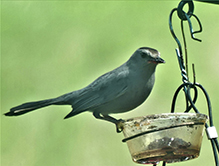 |
|
Catbirds Devouring Oranges A new observation for us. They, the Orioles and House Finches polish off an orange a day. |
Catbird | |
Margot Avey |
||
 |
||
It was in the marshy area. |
||
Ramona Abrego |
||
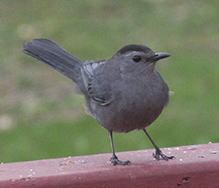 |
||
Roger |
||
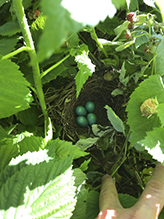 |
||
Has a nest in my raspberries with blue eggs, next day chicks |
||
Lynn Rubey |
||
| A Gray Catbird foraging on the ground in The Big Stone National Wildlife Refuge, a rather secretive bird that the Chippewa Indians named "the bird that cries with grief" due to its raspy call. It will only nest in thick shrubs. | 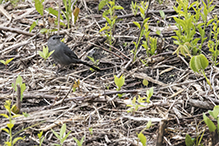 |
|
Bill Reynolds |
||
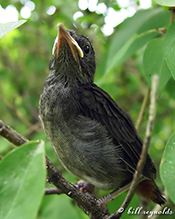 |
||
Tom Baker |
||
 |
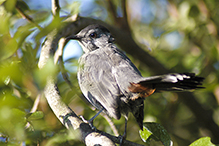 |
|
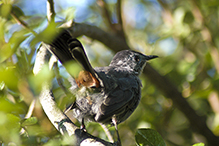 |
||
MinnesotaSeasons.com Photos |
||
 |
|

Slideshows |
Gray Catbird |
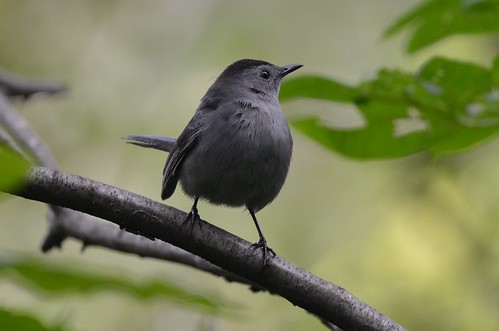
|
Gray Catbird |
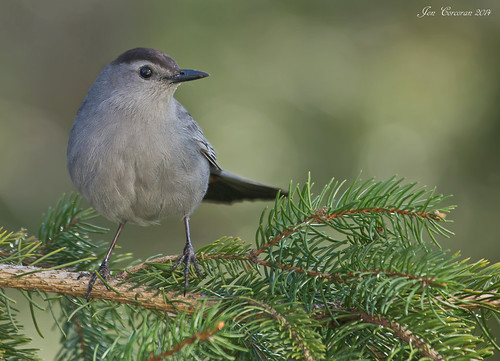
|
Gray Catbirds |
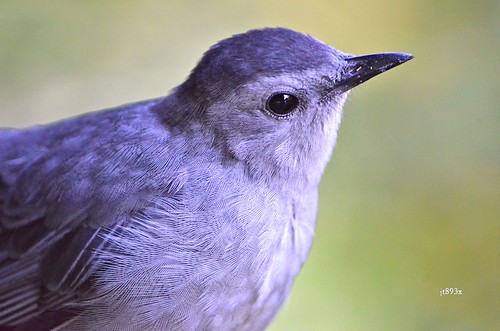
|
Gray Catbird |
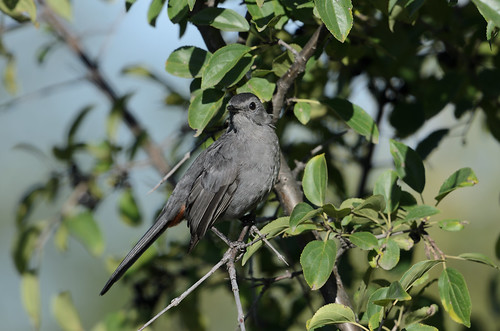
|

Visitor Videos |
||
Share your video of this bird. |
||
This button not working for you? |
||
|
Other Videos |
||
Catbird (Dumetella carolinensis) mating song |
About
Uploaded on May 19, 2011 Grey Catbird (Dumetella carolinensis) mating song in rose bush... 5-18-11...no video of bird, sorry...I had to hide the camera in the bush, & wait for the male to return. |
The Gray Catbird (Mimidae: Dumetella carolinensis) |
About
Uploaded on Dec 28, 2009 A brief but contemplative look at the Gray Catbird, which is an often heard but seldom seen avian species found in deciduous and riparian habitats throughout the upper midwest of the United States. Specimens shown here were photographed in North Dakota. |
Gray Catbirds (Dumetella carolinensis) |
About
Published on May 14, 2013 In this video, two gray catbirds (Dumetella carolinensis) are shown hopping around branches in a small ravine. This video was recorded on May 11, 2013 in Guilford, Connecticut. |
Gray Catbird Mewing - June 25, 2013 |
About
Published on Jun 27, 2013 Gray Catbird (Dumetella carolinensis) Mewing, Yellow Trail, Emilie Ruecker Wildlife Refuge, Seapowet Avenue, Tiverton, Rhode Island, Tuesday afternoon, June 25, 2013, 5:14 PM - Canon PowerShot SX50 HS MVI_23490; 2:54 min. |

Visitor Sightings |
||
Report a sighting of this bird. |
||
This button not working for you? |
||
Donald Lien |
Location: Montevideo, MN quite a few of them eating jelly I have out for Baltimore orioles |
|
| Gregory Gilman 5/17/2025 |
Location: Rochester, MN A new observation for us. They, the Orioles and House Finches polish off an orange a day. |
 |
platt |
Location: Red Wing, MN we have had a pair (male and female) feeding all day long at our oriole feeder-specifically out of the two glass cups filled with grape jelly, which are attached to the feeder. they go between our oriole feeder and our open-holed hummingbird feeder-frequently just sitting on it sucking out the nectar, tho not when the hummers are there! |
|
Chuck Becker |
Location: Chanhassen, MN I saw two gray cat birds at our sunflower seed fly through feeder. Then they went to our suet seed feeder, then they ate grape jelly from our Oriole feeder. We have lived in our Chanhassen town home 44 years and this is the first time we have ever seen them. |
|
| Jennifer 7/1/2023 |
Location: St Paul, Midway Nesting pair appear to be in either my or my neighbor's backyard (raspberries, oak tree, vine/shrubs are all possible locations). They've been around for a while but today they were very noisy at my neighbor's cat in their yard so I finally looked up what they were. |
|
| Kathybe 6/7/2021 |
Location: Plymouth MN This bird hit my 2nd story window, and lay on the concrete below. I thought he would die, and it was 97 degrees, so put a bucket beside him to shade him. 4 hours later he is standing, which surprised me. I moved him with to shade behind my garage and make him a house out of a small box with both water and grape jelly inside. He did not seem afraid. He stays overnight in his box house. I check on him in the morning, and see his jelly is almost gone. I bring more jelly to his house, and he flies out and lands in my yard. Then flies away. |
|
| Lemke 5/31/2021 |
Location: Forest Prairie Township, Central Minnesota Had a pair hanging out in our yard this morning. |
|
| Gregory Gilman 5/30/2020 |
Location: Rochester, MN Catbird |
 |
| Ramona Abrego | Location: Washington County |
 |
| Margot Avey 7/30/2019 |
Location: Westwood Nature Center in St. Louis Park MN It was in the marshy area. |
 |
| Roger 7/12/2019 |
Location: Maplewood MN Has a nest in my raspberries with blue eggs, next day chicks |
 |
| kjtitan16 7/5/2019 |
Location: North Branch Quite vocal, constantly calling from around our campsite |
| Gavia Immer 5/27/2019 |
Location: eDuluth, MN; Hunter's Park Neighborhood at suet feeder; potentially nesting in White Cedar Grove |
April |
Location: Eden Prairie |
| Tom Baker 8/18/2012 |
Location: Purgatory Creek Park |
 |
| Tom Baker 6/25/2012 |
Location: Purgatory Creek Park |
 |
| Bill Reynolds 6/29/2013 |
Location: Pennington Co. |
 |
MinnesotaSeasons.com Sightings |
||

|
Created: Last Updated: © MinnesotaSeasons.com. All rights reserved. |
